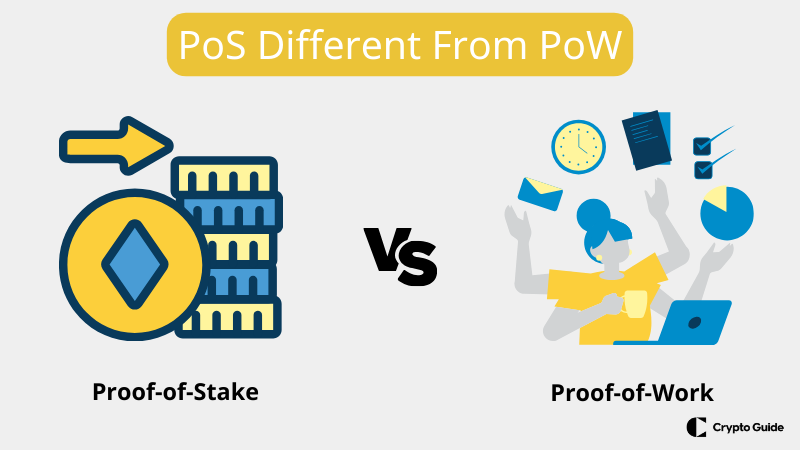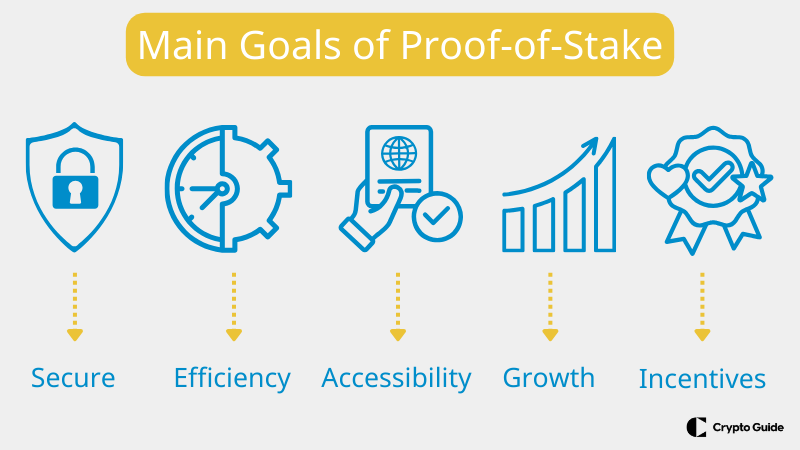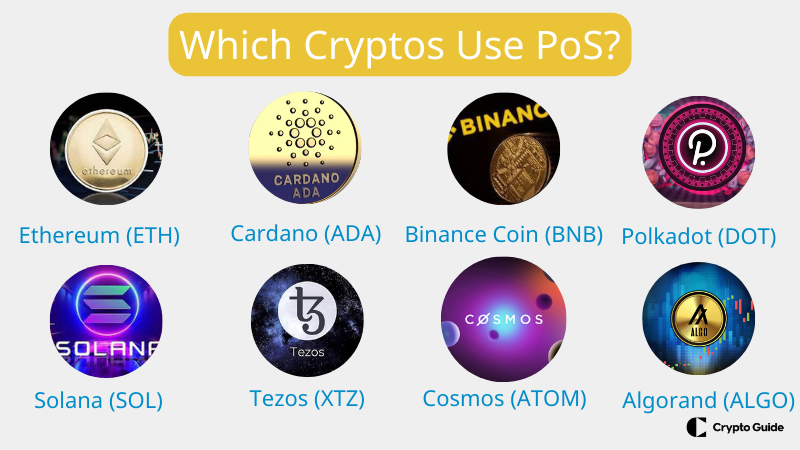What Does Proof-of-Stake (PoS) Mean in Crypto?
In Proof-of-Stake, you can lock up your cryptocurrency to earn rewards by validating transactions, similar to staking. In this article, our experts provide a detailed explanation of PoS and provide its examples, benefits and drawbacks.
Table of content
- What Is Proof-of-Stake in Blockchain?
- How does Proof-of-Stake Work?
- How Is Proof-of-Stake Different From Proof-of-Work?
- Main Goals of Proof-of-Stake
- Proof-of-Stake Security
- Proof-of-Stake Benefits
- Proof of Stake Drawbacks
- Which Cryptocurrencies Use Proof of Stake?
- Final Words on Proof-of-Stake (PoS)
- FAQ About Proof-of-stake (PoS)
What Is Proof-of-Stake in Blockchain?
Proof-of-stake (PoS) is a consensus mechanism used in blockchain networks to achieve agreement on the state of the blockchain. Unlike Proof-of-Work (PoW), which requires miners to solve complex mathematical puzzles to validate transactions and create new blocks, PoS selects validators to create and validate new blocks based on the amount of cryptocurrency they hold and are willing to “stake” as collateral.
Here are some key points about PoS:
- More energy-efficient: Since it doesn't rely on brute computational power, PoS consumes much less energy than PoW.
- Faster transaction times: Due to its simplified validation process, PoS blockchains can often process transactions faster than PoW chains.
- Increased accessibility: Anyone with enough cryptocurrency can participate in staking, unlike PoW, which requires specialized hardware.
- Security concerns: Some argue that PoS systems are less secure than PoW, as large stakeholders could potentially manipulate the network.
How does Proof-of-Stake Work?
Here is a breakdown:
- Staking: In a PoS system, participants, often called validators, must “stake” a certain amount of the native cryptocurrency of the blockchain. This stake serves as collateral and is held in a designated wallet or smart contract. The amount of cryptocurrency staked can vary depending on the specific blockchain protocol.
- Block Creation and Validation: Validators are chosen to create new blocks and validate transactions based on a selection algorithm. The likelihood of being chosen as a validator is often proportional to the amount of cryptocurrency staked—those who stake more have a higher chance of being selected.
- Block Proposal: Validators selected to create a new block propose a new block with a set of transactions. This proposed block includes a cryptographic hash of the previous block, forming a chain of blocks – the blockchain.
- Voting: Other validators in the network then assess the validity of the proposed block. They can vote on whether they believe the proposed block is valid or not. Validators may have the option to vote directly, or their stake might automatically vote on their behalf.
- Consensus: Consensus is reached when a supermajority of validators (often a two-thirds majority or more) agree on the validity of the proposed block. Once consensus is achieved, the block is added to the blockchain, and the process begins again for the next block.
- Reward Distribution: Validators who participate in block creation and validation are rewarded with transaction fees and sometimes newly minted coins. The rewards are distributed among validators based on their stake and participation in the network.
- Penalties: Validators who act maliciously or attempt to validate fraudulent transactions can face penalties, including having a portion of their staked coins slashed or losing their staking rights temporarily or permanently.
- Security: PoS systems often incorporate mechanisms to ensure network security and prevent centralization. This may include randomizing the selection of validators, penalties for dishonest behavior, and mechanisms to prevent a single entity from controlling a significant portion of the network.

Overall, PoS offers an energy-efficient alternative to PoW consensus mechanisms and incentivizes validators to act honestly in securing the network.
How Is Proof-of-Stake Different From Proof-of-Work?
Proof-of-Stake (PoS) and Proof-of-Work (PoW) are two fundamental consensus mechanisms used in blockchains to validate transactions and secure the network. While both achieve the same goal, their approaches differ significantly, leading to distinct advantages and disadvantages.
Here's a breakdown of the key differences:
| Feature | Proof-of-Stake (PoS) | Proof-of-Work (PoW) |
| Validation Process | Staking cryptocurrency | Solving complex puzzles with computing power |
| Energy Consumption | Very low | Very high |
| Accessibility | Anyone with enough cryptocurrency can stake | Requires specialized hardware |
| Security | Evolving, potential concerns with large stakeholders | Established, but vulnerable to mining pool attacks |
| Transaction Speed | Generally faster | Generally slower |
| Decentralization | Can be less decentralized due to mining pool concentration | Can be highly decentralized |
| Environmental Impact | Low | High |
| Cost of Entry | Lower | Higher |
| Rewards | Earned for validating blocks | Earned for mining blocks |
| Maturity | Newer technology | Established technology |
Validation Process
- PoW: Mining secures blockchain networks by solving complex mathematical puzzles, validating transactions, and creating new blocks, incentivizing miners with rewards for their computational efforts.
- PoS: Users “stake” their existing cryptocurrency holdings, essentially locking them up for a period. The amount staked determines their chance of being randomly selected as a validator for the next block. Validators verify transactions and add new blocks to the chain, earning rewards for their work.
Energy Consumption
- PoW: Due to the competitive mining process, PoW blockchains like Bitcoin consume vast amounts of energy, raising environmental concerns.
- PoS: By eliminating the need for powerful mining hardware, PoS blockchains are significantly more energy-efficient, reducing their environmental impact.
Accessibility
- PoW: Participating in PoW mining often requires expensive specialized hardware, making it less accessible to individuals with limited resources.
- PoS: Anyone with enough cryptocurrency can participate in staking, making it more accessible and democratic.
Security
- PoW: The distributed nature of mining with many participants makes PoW blockchains generally resistant to attacks. However, the possibility of large mining pools gaining control raises security concerns.
- PoS: While PoS offers decent security, some argue that large stakeholders with significant amounts of staked crypto could potentially manipulate the network. This is a topic of ongoing debate and research.
Transaction Speed
- PoW: The complex validation process in PoW can lead to slower transaction times, especially during periods of high network activity.
- PoS: The simpler validation process in PoS often results in faster transaction speeds compared to PoW.
The choice between PoW and PoS depends on the specific priorities of the blockchain project. While PoW offers proven security, its energy consumption is a major drawback. PoS presents a greener and more inclusive alternative but is still under development, and its long-term security implications are being evaluated.
Main Goals of Proof-of-Stake
- Secure and Decentralized Network: Like PoW, PoS primarily aims to secure the blockchain network and maintain its decentralization. This means ensuring the accuracy and immutability of transaction data while remaining resistant to manipulation or control by any single entity.
- Improved Efficiency: PoS seeks to achieve security and decentralization more efficiently than PoW. It eliminates the need for energy-intensive mining, leading to faster transaction processing and lower environmental impact.
- Enhanced Accessibility: PoS aims to make blockchain participation more accessible by removing the hardware barriers associated with PoW mining. Anyone with enough cryptocurrency can participate in staking, promoting broader network involvement.
- Sustainable Growth: PoS strives to ensure the sustainable growth of the blockchain ecosystem by addressing the high energy consumption concerns of PoW. This enables wider adoption and real-world application potential.
- Dynamic Incentives: PoS encourages participation by offering dynamic rewards for validating transactions and securing the network. This encourages honest behavior and discourages wrong activities.

While security remains the core objective, PoS aims to achieve it in a more efficient, accessible, and sustainable manner, paving the way for the broader adoption and evolution of blockchain technology.
Proof-of-Stake Security
PoS security revolves around two main principles: economic incentives and randomized validation. Both work together to create a system where honest behavior is rewarded and malicious activity is penalized.
Economic Incentives
- Staking: Users “stake” their own cryptocurrency, essentially locking them up for a period. This acts as collateral, similar to a security deposit.
- Slashing: If a validator behaves dishonestly, they lose a portion of their staked cryptocurrency, creating a strong urge for cheating.
- Rewards: Honest validators who help secure the network earn rewards, further motivating them to act honestly.
Randomized Validation
- Validators: Not everyone can validate transactions. Instead, validators are chosen randomly based on their stake size and other factors.
- Difficult to Attack: This randomness makes it difficult for any single entity to control the network or manipulate transactions, as they wouldn't know who the validators are in advance.
- Byzantine Fault Tolerance (BFT): Some PoS systems use BFT, allowing the network to function even if a small number of validators are malicious or unavailable.
Challenges and Considerations
- Stake Concentration: If a small group controls a large portion of the staked coins, they could potentially manipulate the network. This is a major concern and an active area of research.
- New Technology: PoS is newer than PoW, and its long-term security implications are still being studied and debated.
- Social Engineering: Targeted attacks could trick validators into acting badly.
- Smart Contract Vulnerabilities: Vulnerabilities in smart contracts deployed on the blockchain can be exploited, regardless of the consensus mechanism.
PoS offers a promising approach to blockchain security, but it's not perfect. Security is an ongoing process, requiring constant monitoring, updates, and research to address evolving threats. The choice between PoS and PoW depends on the specific needs and security priorities of the blockchain project.
Proof-of-Stake Benefits
- Energy Efficiency: PoS eliminates the need for energy-intensive mining hardware, significantly reducing the environmental impact of blockchain technology. This aligns with growing concerns about the sustainability of PoW systems like Bitcoin.
- Faster Transactions: PoS generally offers faster transaction processing times compared to PoW. This is due to the simplified validation process, where validators are chosen randomly instead of competing through complex computations.
- Increased Accessibility: Anyone with enough cryptocurrency can participate in staking, making PoS more accessible than PoW, which requires specialized hardware. This broader participation strengthens the network's decentralization and security.
- Lower Transaction Fees: Due to the reduced energy consumption and simplified validation process, PoS blockchains often have lower transaction fees compared to PoW blockchains. This can be especially beneficial for microtransactions and everyday use cases.
Proof of Stake Drawbacks
- Stake Concentration: If a small group of individuals or entities hold a significant portion of the staked coins, they could potentially manipulate the network or influence decision-making.
- Delegation and Pooling: Validators can delegate their staking power to third parties, creating staking pools. While this increases accessibility, it could also lead to centralization if large pools gain too much influence.
- Newer Technology: Compared to PoW, PoS is a relatively new technology, and its long-term security implications are still being actively researched and debated.
- Social Engineering Attacks: Targeted social engineering attacks could potentially trick validators into acting badly.
- Smart Contract Vulnerabilities: Vulnerabilities in smart contracts deployed on the blockchain can be exploited, regardless of the consensus mechanism.
- Initial Coin Distribution: Depending on how the initial cryptocurrency was distributed, there could be concerns about fairness and potential centralization if a large share is concentrated in the hands of a few.
- Nothing-at-Stake Attacks: Some PoS implementations might be vulnerable to “nothing-at-stake” attacks, where validators can validate both valid and invalid blocks without penalty.
- Regulatory Uncertainty: The regulations surrounding cryptocurrencies and PoS systems are still developing, creating uncertainty for users.
Which Cryptocurrencies Use Proof of Stake?
Several prominent cryptocurrencies use Proof-of-Stake (PoS) consensus mechanisms, including Ethereum (ETH), Cardano (ADA), Binance Coin (BNB), Polkadot (DOT), Solana (SOL), Tezos (XTZ), Cosmos (ATOM), and Algorand (ALGO).

- Ethereum (ETH): Currently transitioning from PoW to PoS through its Ethereum 2.0 upgrade, aiming for increased scalability and efficiency.
- Cardano (ADA): One of the first widely adopted PoS blockchains, known for its research-based approach and focus on smart contracts.
- Binance Coin (BNB): Native token of the Binance exchange, implemented a hybrid PoS and Proof-of-Authority (PoA) system for faster transactions.
- Polkadot (DOT): Multi-chain network with a unique sharding architecture, utilizing PoS for its main chain and allowing flexibility for different consensus mechanisms on individual parachains.
- Solana (SOL): High-performance blockchain known for its fast transaction speeds and low fees, uses a unique hybrid PoS mechanism with validator nodes and proof-of-history.
- Tezos (XTZ): On-chain governance platform known for its formal verification process and amendments, operates with a delegated PoS system.
- Cosmos (ATOM): Hub blockchain connecting independent blockchains, uses a Byzantine Fault Tolerance (BFT) based PoS system for its main chain.
- Algorand (ALGO): Pure PoS blockchain known for its efficient and secure consensus mechanism, designed to be fast and scalable.
Final Words on Proof-of-Stake (PoS)
PoS offers a promising alternative to PoW, addressing its key limitations. However, it's essential to be aware of its challenges and ongoing development efforts to ensure a secure and decentralized future.
FAQ About Proof-of-stake (PoS)
What is proof-of-stake in simple terms?
With PoS you, instead of mining, lock up your crypto to earn rewards for validating transactions.
What Is Proof-of-Stake vs. Proof-of-Work?
Stake your crypto vs. solve puzzles with computers, both secure the network but stake is more energy-efficient and accessible.
Can you make money with proof-of-stake?
Yes, by staking your crypto and earning rewards.
Is Bitcoin a proof-of-stake?
No, Bitcoin uses proof-of-work (mining).
Why is proof of stake safe?
Validators put their own crypto at risk, making them more likely to act honestly.
What is the risk of staking crypto?
Staking crypto involves risks such as liquidity constraints—your funds are locked and inaccessible for a period—and market volatility, which can reduce the value of your staked assets.




![Top 10 Best Crypto Staking Platforms for [year]](https://betoncrypto.io/app/uploads/2024/12/cryptostaking.webp)

![Best Cryptos to Stake in [year]](https://betoncrypto.io/app/uploads/2024/11/image1-4.webp)
